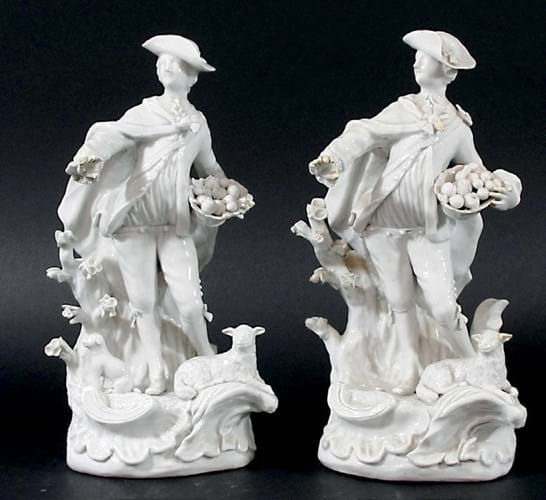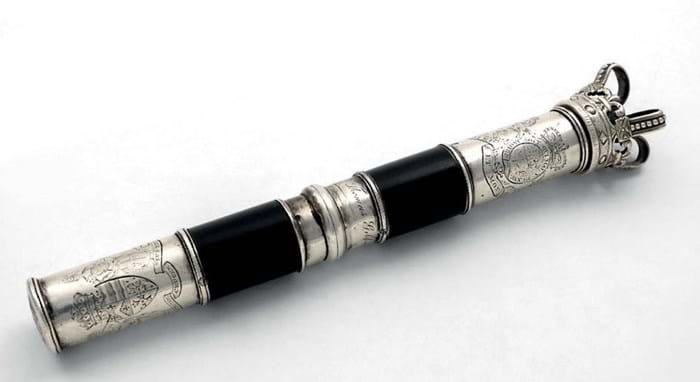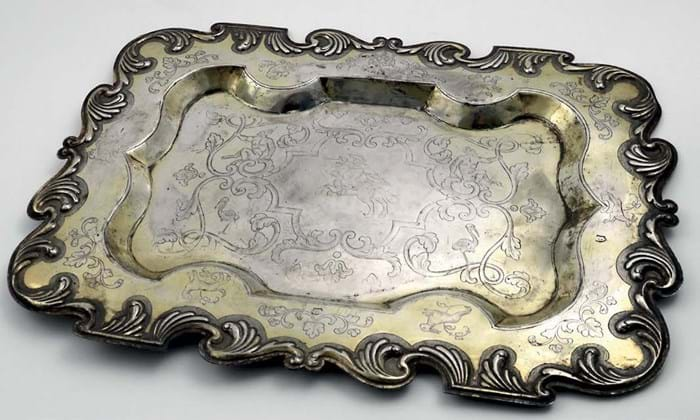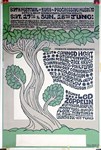The first major ‘fine art’ sales since lockdown at Lawrences (25% buyer’s premium) of Crewkerne went with an encouraging bang of the gavel.
As well as busy international online buying, social distancing rules allowed bidders in the room – something “that always creates a brisk atmosphere and sales go well as a result,” said Lawrences managing director Helen Carless.
Statistics provide an upbeat overall snapshot of the middle market. The three-day July 21, 23 and 24 auction topped £880,000 from the 85% of the 2000-plus lots which sold.
Gilbody versions
No lot at Lawrences was more talked about post-sale than the pair of 18th century ‘in the white’ porcelain shepherds.
Described in the July 23 catalogue as ‘Late 18th century, possibly Derby, modelled as The Dresden Shepherd’, the 9in (23cm) tall figures were estimated at £100-200.
When they sold at £10,000 it was speculated that they were earlier, made in Derby, c.1755, during the so-called ‘dry edge’ period. A single undecorated figure of the model (with a broken and restuck arm) sold as Derby for £750 at Bonhams Knightsbridge in 2016.
In fact, the two specialists, a collector and a dealer, who competed for the figures told Lawrences specialist Neil Grenyer that they were by Samuel Gilbody, the short-lived, 1754-61 Liverpool factory whose wares are the rarest of any from the city.
“The model is based on a Meissen original which Derby copied. Specialists agreed 99% of people would think they were Derby,” said Grenyer.
“By all accounts only two other Gilbody versions exist, one in the Liverpool museum. The model was confirmed as Liverpool only because a curator happened to see some shards in the ground when the road outside the Liverpool museum was being dug up – or so the story goes.
“The collector won them on the day but the trade underbidder may well offer to buy one from the buyer.”
Silver sets the pace
The three-day Crewkerne marathon began with a 500-lot silver sale and with a sale rate of more than 85% and a £210,000 total to set the pace.
English standards and rarities selling to UK collectors provided a solid base – an 8in (20cm) long laceback trefid spoon by Thomas Issod, London, c.1683, at a quadruple-estimate £1300; a shallow, 3in (7cm) diameter tumbler cup probably by Robert Makepeace, Newcastle, 1721, taking a seven-times-estimate £3600 and a Paul Storr crested fish slice, London, 1813, which doubled expectations at £1450.
Quintessentially English was a 9¾in (25cm) silver-mounted ebony tipstaff, marked with a worn maker’s mark for London 1794. Engraved with the Royal Coat of Arms and inscribed Court of Kings Bench The Right Honble. Edward Ld. Ellenborough, it sold at £3400 against a £600-800 estimate.
Spanish tray
However, it was the demand for overseas silver which really caught the eye.
Rarely seen on British rostrums was a 20½in (52cm) long Spanish Colonial silver-gilt tray dated 1800-20. It had no maker’s mark but was struck twice for the ‘Captaincy General of Guatemala’ and once for the city of Leon (now in Nicaragua).
Alongside chased scenes of animals and a horseman with drawn sword to the centre, an engraved coronet and motto suggest it was a prestigious gift to Admiral Charles Philip York while serving with the Caribbean fleet before becoming the 4th Earl of Hardwicke in 1834.
Pitched at a modest £800-1200, it went to a Continental bidder at £8500.
From North America came a rare gold vesta case, engraved with a classical figure and wheatsheaf and the word Eureka– a city briefly linked to the Californian gold rush and also the single word motto of the Golden State itself. Probably by Shreve & Co of San Francisco, c.1870, the 2¼in (5.5 cm) long collectable sold to an overseas bidder at £3000 (estimate £400-600).
A silver-gilt and niello teapot bore the maker’s mark AE, assay master Alexei Torlov (of Veliky Ustyug), Moscow 1796.
Engraved with initials to one side and putti and a castle to the other, the 4¾in (12cm) tall teapot was estimated at £500-700 and sold to a UK collector at £5500.
Dutch tobacco box
A strong demand has been evident in recent times for good Dutch tobacco boxes.
The example here, from the 19th century, measured 5in (12cm) and was engraved to the exterior with vignettes representing the four seasons. More suggestive boudoir scenes and lovers were revealed below slide-out panels. It bore a maker’s mark RS over 2 and the Dutch dolphin tax mark. The box fell just shy of the estimate in selling to a UK collector at £3800.
Jumbo mania
The Somerset series ended on July 24 with a 550-lot auction of pictures, furniture and carpets. An intriguing bronze elephant prompted more post-sale discussion.
Catalogued as ‘After the antique, An elephant standing four square, probably the Imperial Elephant Soliman, South German’, bronze, the 3in (7.5cm) high animal was estimated at £400-600 and sold to a UK dealer at £3600.
Famously this elephant, having been transported to Lisbon from Goa, was presented by the king of Portugal to Archduke Maximillian II. After being shipped to Italy and crossing the Alps, it arrived in Vienna in March 1552 and prompted something akin to elephant mania in the Hapsburg empire, not least among artists and bronzeurs. Sadly it died 18 months later.
Grenyer said: “There was some debate of the age of this piece – some enquiries from specialist dealers suggested it could be 16th or 17th century.”
The fact that such interest did not result in a higher bid on the day suggests further research will be required. By way of comparison, a c.1550 north Italian, 4¾in (12cm) high bronze of Soliman took £18,000 at Christie’s in 2013.
The day’s clocks offering was led by a 19th century regulator inscribed to the silvered dial Jas Muirhead Glasgow for the highly regarded maker to the Admiralty. In a 6ft 5in (1.96m) tall satinwood case, the regulator sold to the UK trade a shade over top estimate at £6500.
Furniture presented the usual picture. Decent Georgian and 19th century furniture largely sold in three figures. In contrast, the continued strong demand for Howard & Son sofas and chairs was again evident. Best-seller was a 6ft 2in (1.88m) long sofa.
It was stamped to the sacking and castors with the company name, to a leg with the serial number 16821 832 and had a paper label Howard & Son, Berners Street, the central London workshop from 1848-1935.
With its original striped floral fabric, it was always going to make the £500-800 estimate irrelevant and it sold to a UK private buyer at £8500.





















